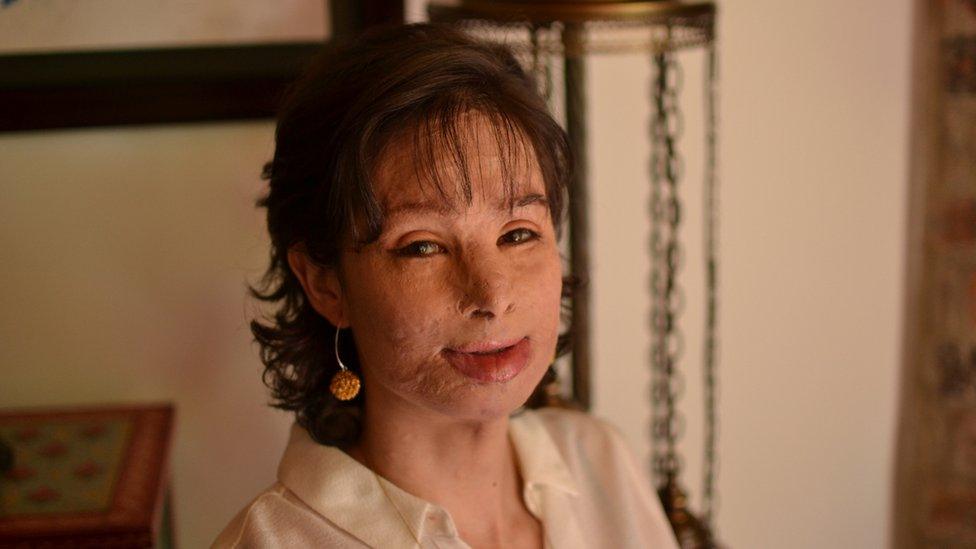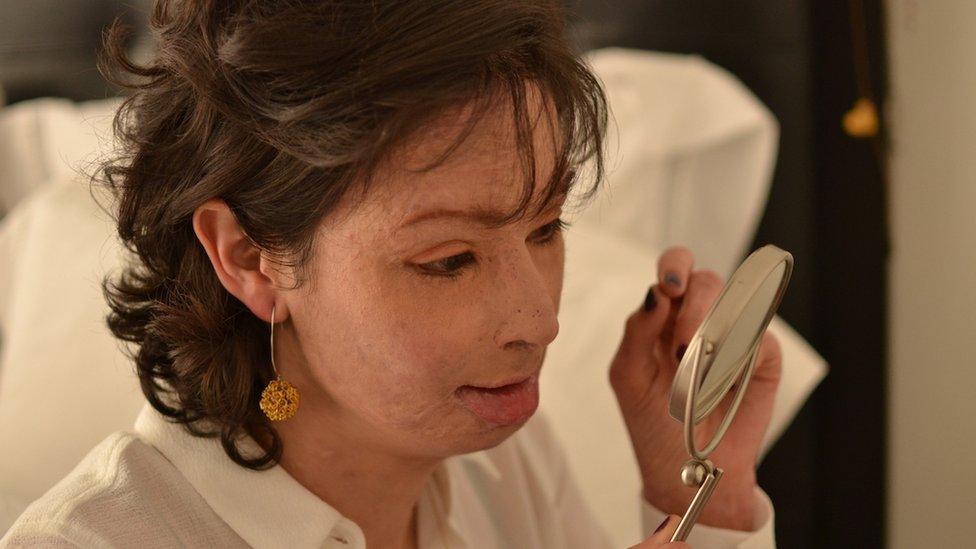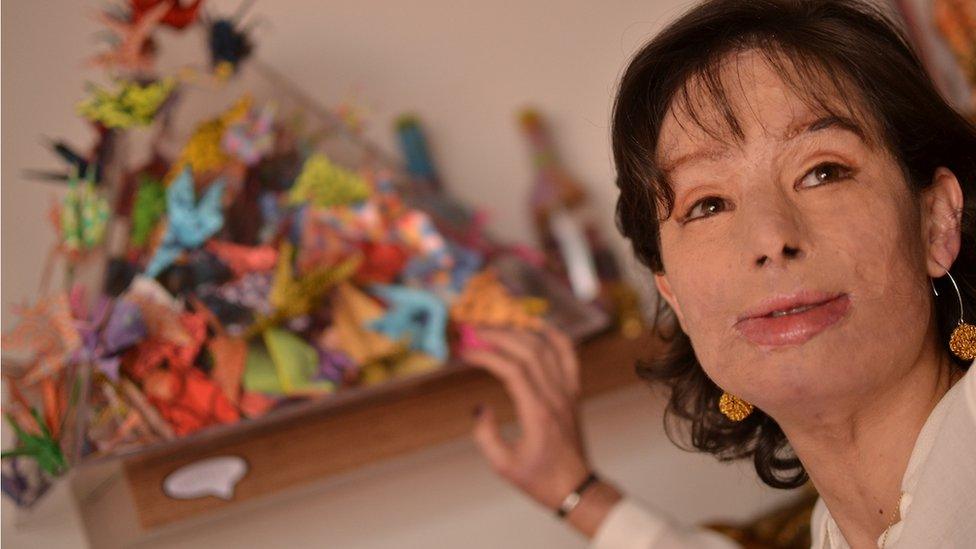Colombian acid attack victim Natalia Ponce's long recovery
- Published
Colombian acid attack survivor reflects on her face being rebuilt
At 35, Natalia Ponce de Leon is an expressive woman, with the vivid eyes of a person who once thought that she would lose her sight.
Her mother's home, where Natalia lives, is usually in half-light, because sunlight is not good for burns.
She suffered them twice - serious ones.
When she was three years old, she went to pick up a ball on the road, and got stuck under a car exhaust. Her face was badly burned.
The second one took place 30 years later. A man she had barely even seen before threw a litre of acid over her, burning her face, her arms, her abdomen and one of her legs.
She does not understand why he did it.
Colombia toughens law on acid attacks
Indian acid attack survivor becomes face of fashion brand
Acid sales 'should be restricted'
How many acid attacks are there?
Natalia spent weeks in hospital. She had to go through dozens of operations, and much more surgery lies ahead of her.
She was the victim of one of the most savage acid attacks ever recorded in Colombia - and it has one of the highest number of cases in the world.
'It felt like water'

"My clothes started to dissolve - then I felt the burning"
On 27 March 2014, Natalia's neighbour Jonathan Vega pretended to be an ex-boyfriend to make her come to the door so he could pour sulphuric acid on her.
"It felt like water", she says of the moment when the acid touched her skin.
"I didn't know what it was. I don't remember a smell, or anything.
"My clothes started to dissolve - then I felt the burning. I went into the house screaming."
Natalia's mother, Julia Gutierrez de Pineres, says: "I almost died that day."
Mrs Gutierrez was with her daughter when she was just three and had to spend five months indoors after the car exhaust burn.
She was also with Natalia through her long recovery after an acid attack that shocked Colombia.
Learn to blink
Natalia's main fear was that she might become blind.
"Light bothered me. I couldn't close my eyes because I didn't have eyelids.
"I had to wear some cones so that my eyes got hydrated and to protect my corneas from damage," she says.
Doctors operated on her eyelids about four times and in that process she had to learn how to blink again.
She did not go blind, but even the idea that she could have makes her still very anxious.
She reflects on the case of an Iranian woman who had the chance to blind her attacker in retaliation for taking her eyesight in an acid attack.
The talion law, meaning an eye for an eye, is valid in Iran.
Ameneh Bahrami pardoned the man instead.
Had Natalia been in Ms Bahrami's place, she says, she might have acted differently.
"Revenge is not a way to heal," she says.
But then she says: "If I had been blinded and then given the chance of making that man live through the same suffering I had gone through, I would do it."
She did not have to face that choice.
'Fear of the mirror'

Natalia did not recognise herself when she looked in a mirror for the first time after the attack
But having kept her eyesight did force her to face her new self in the mirror - not an easy encounter, by her own account.
"The first time I looked at the mirror I almost died," she says. "I didn't recognise myself. I was a monster.
"I told myself: 'There is no point in going on like this.'"
Natalia suggests she thought about suicide many times.
But with time and repeated operations her face improved, and Natalia got used to looking at her new self.
"My aunt gave me a small magnifying mirror and I always keep that mirror with me.
"We are best friends now," she says with a smile. "I've lost my fear of the mirror."
For some time now, Natalia has been comfortable moving around the streets.
She is an elegant woman and before the interview, she insists I should wait until she has finished applying her make-up.
Before the attack, she did not wear make-up.
Masks

Natalia has now stopped hiding her face behind her treatment masks when in public
The house is full of beautiful masks - on walls, on tables, in Natalia's room.
There are also medical masks, part of her treatment.
She wore them in public for a long time.
But she stopped doing that when a law that toughened the sentences for acid attacks was brought into being. The law is named after her.
She made the decision that same morning.
She was just back from a trip to New York after "spending too much time indoors".
She told herself she looked pretty and it was time to show her face to the world.
Natalia still wears the masks as a treatment.
'Fortunately I didn't lose anything'
Not even two years have passed since the attack and she has achieved a remarkable recovery, thanks to the doctors and her willpower.
"I decided to come through and the result of the evolution is visible," she says.
"I have an expression, I've got skin, I've got my features, my eyes, my nose, my mouth.
"Fortunately I didn't lose anything; my neck wasn't burned, which could have been very hard, my chest didn't get burned either; I didn't lose my hands, fingers, ears."
She says than when we see her next year, once she has completed the remaining surgeries, she will be much better.

Emergency advice: what to do in the case of an acid burn

Advice from Natalia's surgeon in Bogota, Jorge Luis Gaviria:
If you are helping someone who has been burnt with acid, be careful not to become a second victim. Protect your hands.
Do not rip the victim's clothes off. Cut them.
Using a paper towel can help remove up to 80% of the substance that is on the body surface
Wash with clear water for 20 minutes, then apply liquid soap for 15 minutes.
Repeat the last point until the emergency services arrive.
